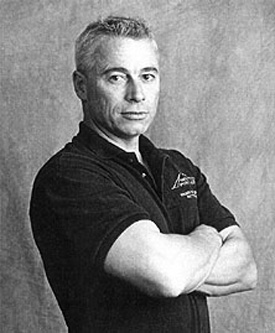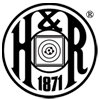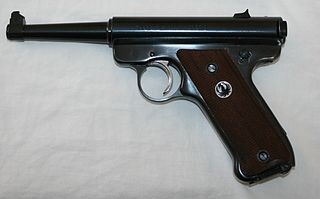
Smith & Wesson Brands, Inc. (S&W) is an American firearm manufacturer headquartered in Maryville, Tennessee, United States.

Glock Ges.m.b.H. is a light weapons manufacturer headquartered in Deutsch-Wagram, Austria, named after its founder, Gaston Glock. The company makes popular polymer-framed pistols, but also produces field knives, entrenching tools, various horse related products, and apparel.

Doppelmayr USA, Inc is an aerial lift manufacturer based in Salt Lake City, Utah, and a subsidiary of the worldwide Doppelmayr Garaventa Group. The United States company was formed in 2002 after the merger of Garaventa of Goldau, Switzerland, and Doppelmayr of Wolfurt, Austria. Between 2002 and 2010, the company was named Doppelmayr CTEC. From 2011 the company has operated using the Doppelmayr brand name, in common with most other Doppelmayr Garaventa Group subsidiaries.
Sturm, Ruger & Company, Inc., better known by the shortened name Ruger, is an American firearm manufacturing company based in Southport, Connecticut, with production facilities also in Newport, New Hampshire; Mayodan, North Carolina; and Prescott, Arizona. The company was founded in 1949 by Alexander McCormick Sturm and William B. Ruger and has been publicly traded since 1969.

Ethan Allen was a major American arms maker from Massachusetts. He is unrelated to the revolutionary Ethan Allen. His first firearm, the "Pocket rifle" was developed in 1836, and his first patent was granted in 1837.

The SIG Sauer P220 is a semi-automatic pistol designed in 1975 by the SIG Arms AG division of Schweizerische Industrie Gesellschaft, and produced by J. P. Sauer & Sohn, in Eckernförde. It is currently manufactured by both SIG Sauer companies: SIG Sauer GMBH, of Eckernförde, Germany; and SIG Sauer, Inc., of New Hampshire, United States.

Buck Knives is an American knife manufacturer founded in Mountain Home, Idaho and now located in Post Falls, Idaho. The company has a long history through five generations of the Buck family from 1902 to the present day. Buck Knives primarily manufactures sport and field knives and is credited with inventing the "folding hunting knife" and popularizing it to such a degree that the term "buck knife" has become synonymous with folding lockback knives, including those made by other manufacturers.

Ernest R. Emerson is an American custom knifemaker, martial artist, and edged-weapons expert. Originally an engineer and machinist in the aerospace industry, Emerson became a knifemaker by producing knives for a martial arts class and making art knives early in his knifemaking career. In the 1980s he became better known for his combat knives and popularizing a style of knife known as the Tactical-folder.

The Smith & Wesson Model 686 is a six- or seven-shot double-action revolver manufactured by Smith & Wesson and chambered for the .357 Magnum cartridge; it will also chamber and fire .38 Special cartridges. Smith & Wesson introduced the Model 686 in 1981. It is the stainless steel version of the Model 586, which featured a blued steel finish. They are available ported and unported with a choice of 6- or 7-round cylinders.

H&R 1871, LLC, or more commonly known as Harrington & Richardson, is an American brand of firearms and a subsidiary of JJE Capital Holdings. H&R ceased independent production February 27, 2015.

The Bren Ten is a semi-automatic pistol chambered for 10mm Auto that was made by Dornaus & Dixon Enterprises Inc. from 1983 to 1986. While the Bren Ten's design has an appearance similar to the 9×19mm Parabellum CZ-75, it is larger and stronger with several unique design elements that make it a distinctly separate firearm. The design was produced only in small numbers before the company went bankrupt. Subsequent attempts to bring the firearm back into production have been unsuccessful.
Strayer-Voigt, Inc. is a manufacturer of M1911-styled modular pistols. The Strayer-Voigt system is called modular because the lower grip and trigger guard, which is made of carbon steel, stainless steel, titanium or aluminum, is a separate component from the metal upper portion of the frame that comprises the dust cover and frame rails. They are the most famous for their Hybrid series of pistols as well as their IMM Open division pistols made for competitions. SVI markets its products under the brand name Infinity Firearms. The Infinity pistols are sometimes unofficially known by the combined name of Strayer-Voigt Infinity among some enthusiasts, a play on the SVI acronym.

The MEU(SOC) pistol, officially designated the M45 MEUSOC, is a magazine-fed, recoil-operated, single-action, semiautomatic pistol chambered for the .45 ACP cartridge. It is a variant of the M1911 for use by the Force Recon Element of the United States Marine Corps' Marine Expeditionary Units from 1985 until 2022. It is assigned NATO Stock Number 1005-01-370-7353.
The CCI Phantom is a Nelson-based pump action paintball marker developed and produced by Mike Casady. Production began in 1987 after about six months of prototype work. The name for the marker was derived from the much more stealth-oriented and drawn-out style of play that was typical when the game was first developing. The Phantom was designed to be powered by a single 12-gram CO2 Powerlet, but larger tanks may also be used by removing the powerlet adapter or using a dummy powerlet. When first introduced the marker featured a fixed barrel assembly referred to as a "unibody" combined with a modified Crosman air pistol frame and brass bead sight. However, since roughly 1989 the body and barrel of the marker have been two distinct parts and no longer feature the bead style sight. The marker is also capable of supporting bulk gravity fed hoppers by using a different breach type. The Phantom is one of only a handful of readily available markers acceptable for use in the various forms of stock class paintball. However, because the Phantom is capable of auto-triggering and features barrel porting it is considered to be a modified stock class marker.

Glock is a brand of polymer-framed, short recoil-operated, locked-breech semi-automatic pistols designed and produced by Austrian manufacturer Glock Ges.m.b.H.

The 1931 Fabrique Nationale (FN) Baby Browning is a small blowback-operated semi-automatic pistol designed by Belgium-born Dieudonné Saive chambered in .25 ACP. The pistol features a six-round magazine capacity and is a striker-fired, single action, blow back mechanism. The manual thumb operated safety locks the slide in the closed position when engaged using side thumb pressure.

The Ruger Standard Model is a rimfire semi-automatic pistol introduced in 1949 as the first product manufactured by Sturm, Ruger & Co., and was the founding member of a product line of .22 Long Rifle cartridge handguns, including its later iterations: the MK II, MK III, and MK IV. It is marketed as an inexpensive .22 caliber rimfire intended for casual sport and target shooting, and plinking. Designed by company founder William B. Ruger, the Standard model and its offspring went on to become the most accepted and successful .22 caliber semi-automatic pistols ever produced.
Nighthawk Custom is an American firearm company based in Berryville, Arkansas, US, that manufactures custom M1911 pistols, rifles, revolvers, shotguns, and tactical knives for competition shooters, military, law enforcement and self-defense.

The SIG Sauer P320 is a modular semi-automatic pistol made by SIG Sauer, Inc., SIG Sauer's American branch. It is a further development of the SIG Sauer P250, utilizing a striker-fired mechanism in lieu of a double action only hammer system. The P320 can be chambered in 9×19mm Parabellum, .357 SIG, .40 S&W, .45 ACP, and 10mm Auto and can be easily converted from one caliber to another; a change from .357 SIG to .40 S&W requires only a barrel change; a change from 9mm to .357 SIG or .40 S&W is accomplished using a caliber exchange kit.
Featureless rifles are rifles with modifications made to remove prohibited features from Modern Sporting Rifles. The term is most commonly used with rifles manufactured or retrofitted to comply with gun laws in California.
















